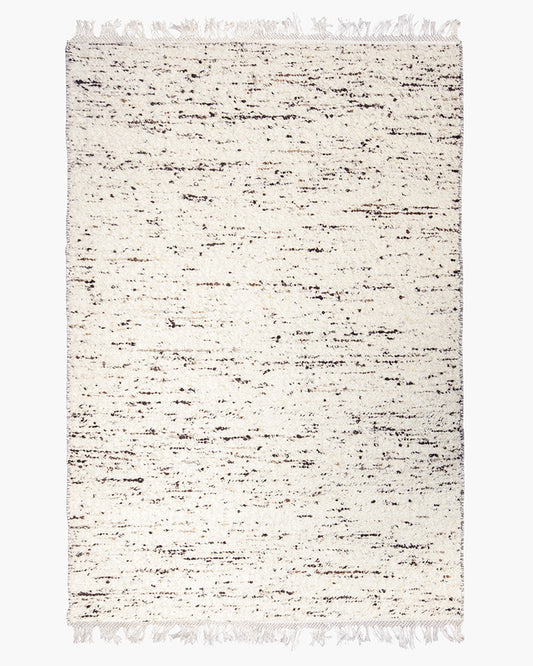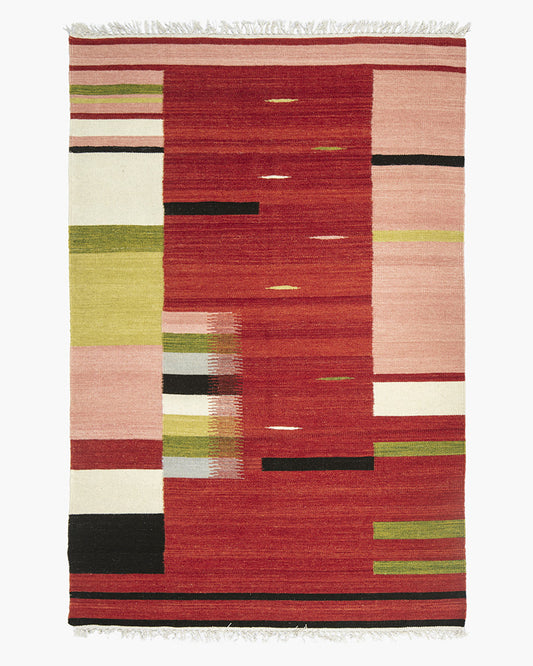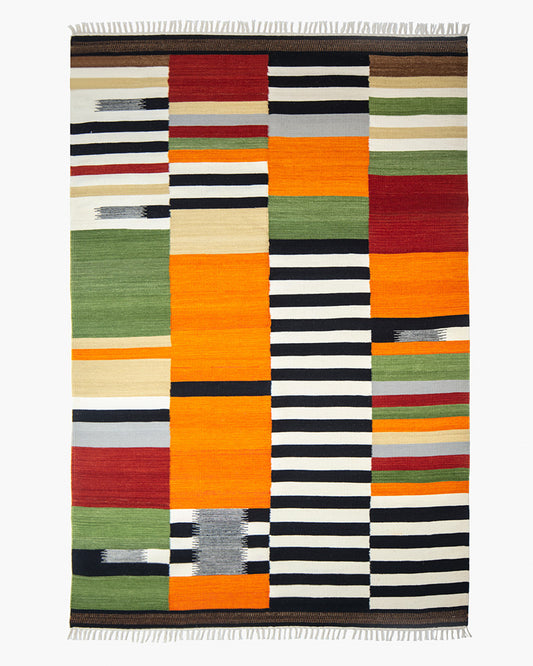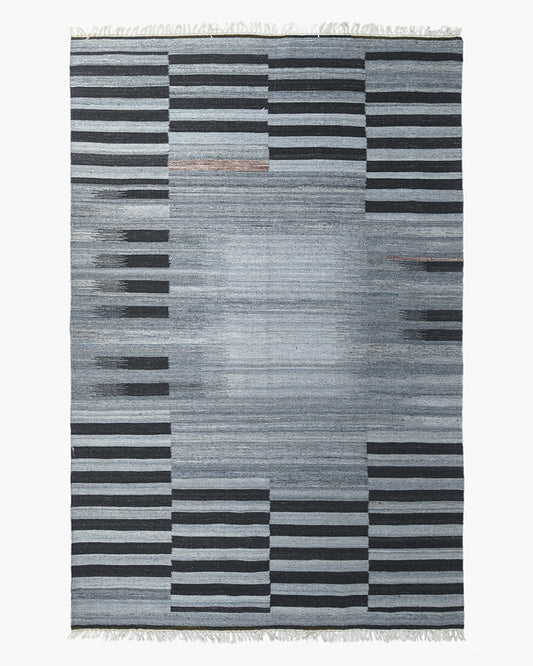Today I’m sending along a conversation Thom and I had in our shared Montreal studio. We explored his approach to design, Canada’s design destiny, and how ritual shapes the way he works. Thom was formerly the Creative Director at EQ3, where we originally met while both working at the company’s head office in Winnipeg. He has since established his own studio and designs furniture, homes and interiors for a myriad of clientele. Recently, he developed a new rug collection for Mark Krebs, launching this summer. Here is a glimpse into the thinking that went behind it.

Davin
Your girlfriend once referred to you as "a boy with his rocks." As we sit here in the studio, I can see a few rocks on the shelves. Do you care to explain yourself? What is the relationship with the stones, and how does that tie into your design approach?
Thom
[laughs] Well, from her perspective, I unknowingly collect rocks when we are travelling. I end up with heavy pockets after hikes. I think there is an inherent beauty in these old things, whether it is the colour, the form, or the texture. Nature is the best designer there is. Maybe I am just fascinated by holding something inherently beautiful in my hand. I cannot fully dissect it; I am just attracted to rocks and heavy things.
Davin
The idea of natural forms and materials plays a prominent role in your practice. Natural form sometimes peaks through, but there is often a linearity or cleanliness to your work. Is there something to that balance?
Thom
I do think I take inspiration from nature, and maybe from stones too. When an object interacts with the human body, it often takes an organic form because we are organic. But when it comes to something like a structure, to hold something up for example, I tend to lean towards geometric forms because they are pragmatically easier to create.

Davin
Something I appreciate about your practice is that you have your own language. Whether or not it is entirely intentional, it feels rooted in paring things down, simplifying, and creating just a few strong gestures. It often gets labelled as minimalism. You have described it before as "walking on a razor-thin edge" when working within that language. Could you elaborate on being pigeonholed as a minimalist and what you mean by that razor's edge?
Thom
People have told me I have a distinct style, but I don’t consciously know what that looks like. It is just what comes out of me. Minimalism can actually be quite maximalist. It sounds contradictory, but when you reduce something enough, it can become very complicated. You are trying to achieve something with as few moves as possible, and that hidden complexity can be very demanding.
There is also a danger in reducing too much and ending up with something that has no personality or does not work. That is the kind of minimalism I cannot relate to. I am from the Prairies, I am very pragmatic. The things I design have to work, they cannot just be beautiful objects.
That is the razor edge I am talking about.
Davin
There is also the issue of aesthetic conservatism, where minimalism becomes a way to avoid taking risks. Some interior designers become incapable of adding colour because they have leaned too far into conservative minimalism. Then there are market pressures that push minimalist designs that are not actually functional or beautiful.
Thom
Absolutely.
This collection with you is interesting new territory for me. I did a lot of this kind of work at EQ3, but designing textiles, something that can be an injection of fashion into a space, is a different challenge. People often want neutral pieces for their homes because they are conservative. Grey sofas sell best. This collection is fairly neutral but also extremely colourful. Finding that balance, fulfilling the desire for neutrality while offering real personality when you look closer, is a dynamic I am excited about.
 Davin
Davin
In reference to the rugs we are doing together, the "razor edge" would be the place where you are injecting something interesting into a simple construction and a simple macro aesthetic.
Thom
It is universal but not boring.
There is a lot of complexity going on within it, even though at a glance it is fairly neutral.
Our collaboration taught me a lot about how rugs are woven together, the role of yarns, and the complexity behind achieving something that appears simple.
 Davin
Davin
What are some of the issues you are seeing today in contemporary design?
Thom
I think design as a global phenomenon has homogenized taste. Everyone is looking at the same things, Pinterest, Instagram, and so we are all influenced by the same imagery.
We are also consuming design much more than we did even ten years ago.
There is a huge desire for education and inspiration, but it ends up creating a lot of sameness. That is why you see interior designers gravitating toward antiques and one-of-a-kind pieces, to inject something unique into otherwise homogenous spaces.
Davin
There are positives to this, but it also leads to a world where everyone considers themselves a designer, and there is so much more noise to sift through.
Thom
Exactly.
Everyone can do it now but standing out while doing it is another thing entirely.
In my opinion, a lot of design is soulless. For example, if I were to turn my solid wood sofa into something made of laminate, it would be a soulless version of the original. We consume furniture the way we consume fashion now. But pieces we live with should ideally be handmade, accessible, and designed to be passed down, not just thrown out every time you move.
Davin
That is something I talk about with rugs too, the goal is to create something multi-generational.
Thom
Exactly.
That is what excites me, pieces that have a soul and stay with you.

Davin
A lot of creative people are creatures of habit. For me, repeating daily routines helps me find the cracks where new ideas live. How do repetition and ritual tie into your process?
Thom
I am very ritualistic.
I try to do the same thing every morning, eat the same breakfast, break for lunch at the same time. That structure helps, but I find inspiration comes from breaking the structure.
It is outside the studio, in life, where the real lightning-bolt ideas strike. The studio is where I work those ideas out.
Davin
Breaking the ritual allows you to see things you take for granted in a new way.
Thom
Exactly.
We overlook so much. Creativity often comes from noticing the things we normally ignore.
Davin
I try to move the artwork around in my house every six months because otherwise, you stop seeing it.
Thom
Absolutely.
You grow accustomed, and it disappears from your perception.
A mixture of structure and surprise is where inspiration lives.

Davin
In addition to product design, you work in architecture and interiors.
You move between disciplines, unlike someone purely an interior designer or purely a product designer. What interior design trends turn you off, and what trends do you find promising?
Thom
I studied architecture originally. At EQ3, we had to predict trends three years ahead, so I tapped into many creative industries. I'm turned off by anything you can describe with a single word, like "Japandi."
By the time something gets a name like that, it’s usually already tired.
I also dislike colour trends, even though I became good at tracking them during my time at EQ3.
Davin
At this point, you’re working based on your own established language, not trends.
Thom
Trends exist because people need a way to interpret what’s happening, but my own work is more about pragmatism, pure materials, and collaboration with clients and the environment. Those are timeless ideas. Of course, I’m still influenced by things like Scandinavian furniture or Japanese spatial design, which are beautiful traditions.
Davin
That’s probably why you’re so sensitive to terms like "Japandi" — they are reductive.
Boiling it down to a style that can be a capsule collection for a corporate furniture brand completely misses the point.
Where would you like to see Canadian Interiors and Canadian design head?
Thom
I don't think Canada will ever have a unified design movement. We’re too geographically spread out. Our eclecticism is our strength. There are many exceptional talents doing very different things, and that’s exciting. Maybe someone from outside could define what ties us together, but from within, it’s just diverse and wide open.
Davin
I always say Canada is an aesthetically underdeveloped nation.
But with absence comes possibility. As the Taoists say, "emptiness leads to use."
Thom
Exactly.
We’re free to define our own paths.
For a closer look at Thom Fougère’s design practice, head to his website or follow along on Instagram.





1 comment
Great interview. Love hearing the thoughts and inspiration from two wonderful designers!